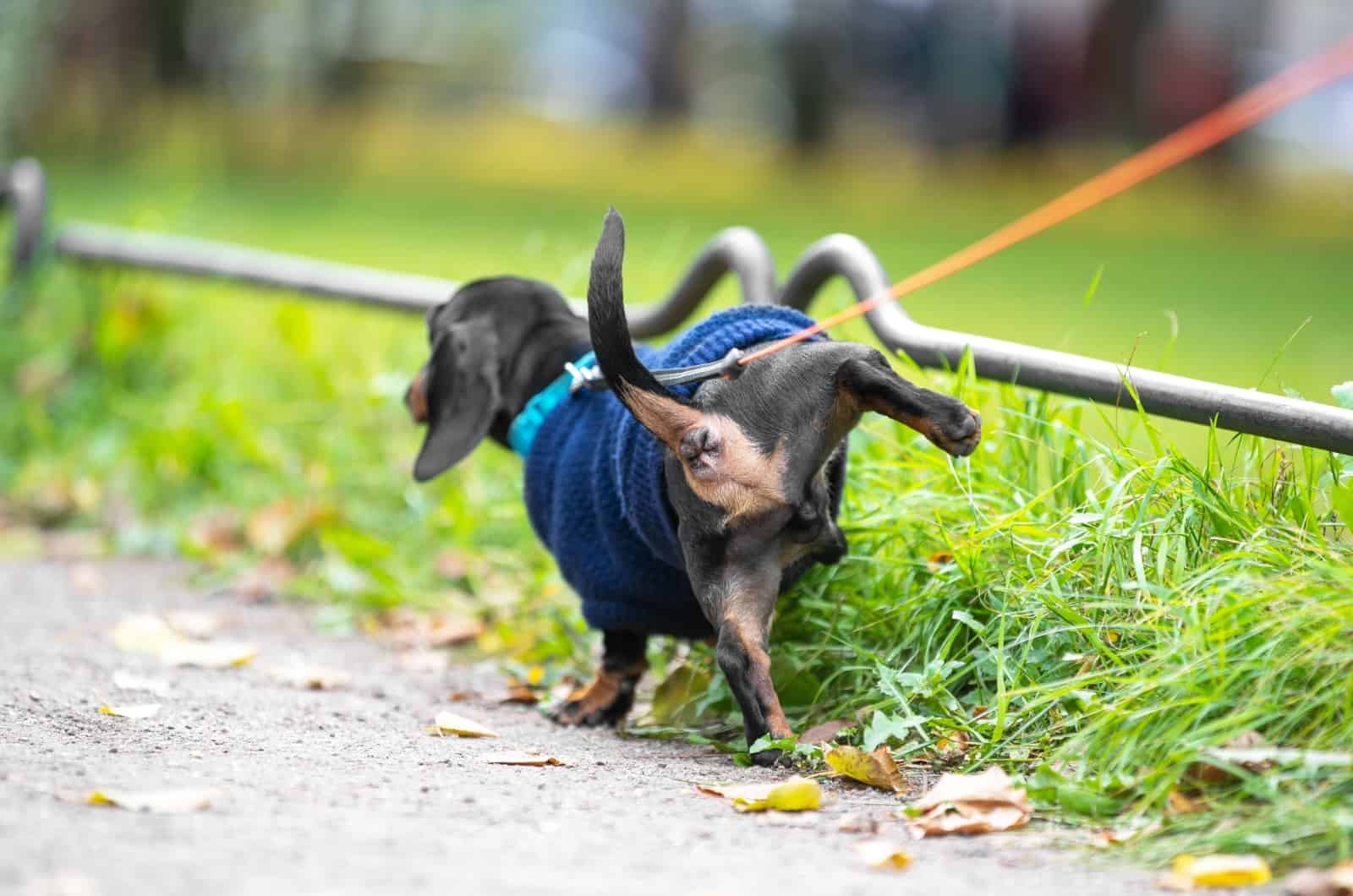Lately, a very interesting topic has been discussed, and that is: How to potty train Dachshunds.
Despite how adorable they are, Dachshunds are especially challenging to housebreak. They are really one of the top 20 breeds that experts say are the most difficult to housebreak, according to studies.
Some Dachshund puppies won’t ever be entirely housebroken; therefore, you’ll require a crate when you’re asleep or away from home. However, most Dachshund puppies can be toilet trained over time.
Just bear this in mind while you train your dog, and exercise patience. Never chastise or punish him for mistakes; instead, employ positive reinforcement strategies, which are much more effective.
You need to teach your Dachshund pup that the single appropriate location for him to relieve himself is outdoors in his allocated area.
Just keep in mind that Dachshund puppies are famously difficult to housebreak, so if you would like your training sessions to be effective, you must have patience, and be willing to work with your dog on a regular basis.
Remember that your puppy’s bladder is smaller than, for example, that of a Bullmastiff or a Doberman, which means it will need to be emptied more frequently.
Important Note Before Potty Training
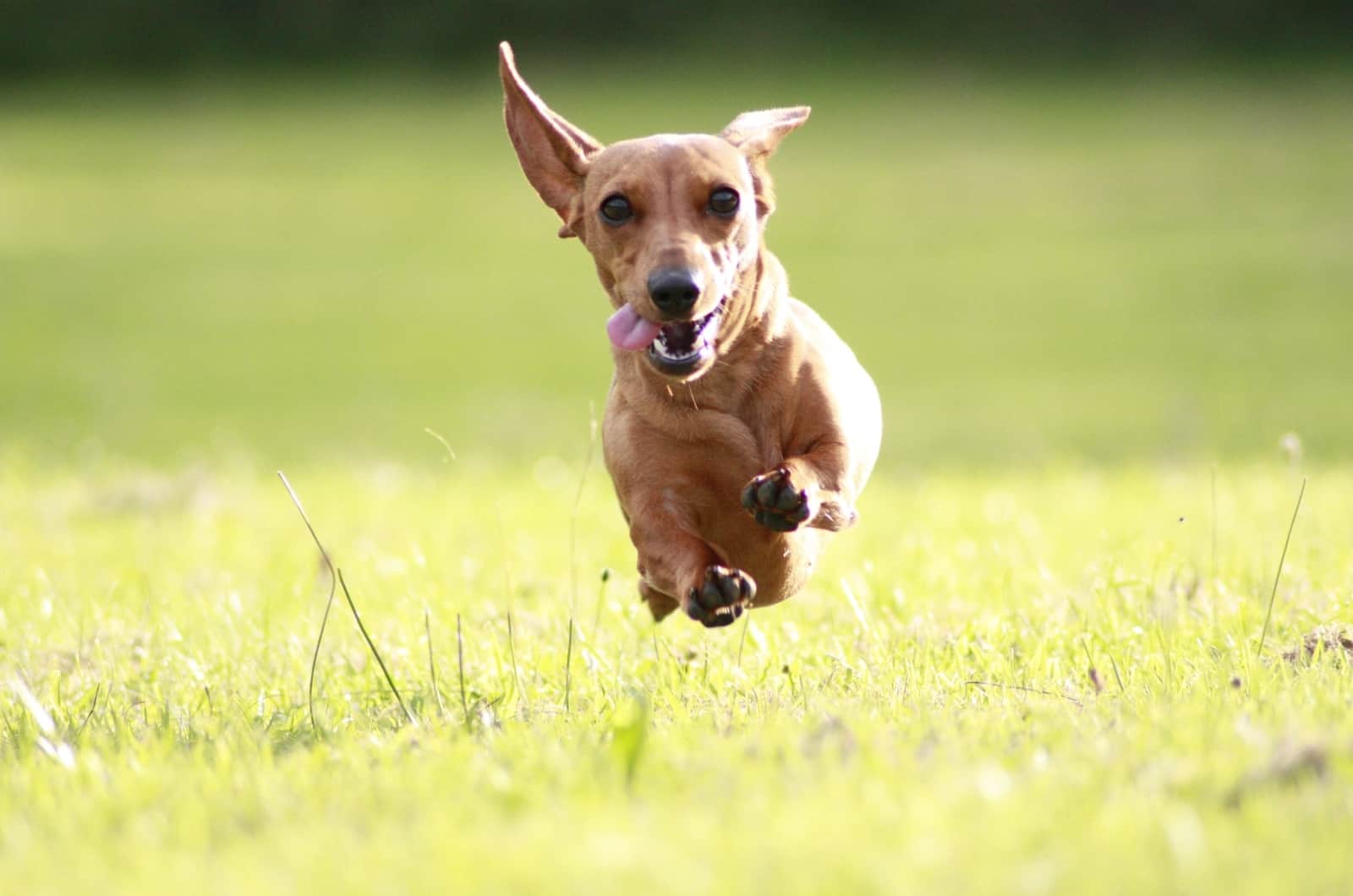
Before the necessary immunizations have been administered, discuss with your veterinarian to make sure it’s okay for your Dachshund breed of dog to step outdoors into your back yard before you start Dachshund potty training.
Many factors could prevent it from being achieved.
For instance, you may have no access to a private and safe space in your yard or garden, you might live in an environment that is too warm or too cold for a young dog to roam around outside, or you could reside in a region where your pup is at danger of contracting canine parvovirus.
Additionally, your home might be too close to wild creatures or unprotected dogs, which could increase your puppy’s chance of contracting canine parvovirus.
Therefore, before you start toilet-training your puppy outside, please ensure you call your veterinarian to confirm it with them.
Advice On Outdoor Puppy Potty Training
Make sure your dog has a harness and is accustomed to wearing it before you begin. To take him outdoors to his designated bathroom location on the grass, you would need this to hook his leash to.
You must be ready to keep an eye on your puppy at all times, or keep him in a kennel when you can’t. You will also require a few extra materials, such as:
- A leash to take him outdoors and have control over the location he goes to
- A kennel or crate training box to restrict the area that the dog has as available
- Treats or a toy (as a reward) – A helpful method to encourage your dog when he is performing well
The final two requirements for properly potty training your dog are a lot of time to spend together, and a significant amount of patience as this will not be a simple task.
You will employ conventional training techniques, but if you intend to succeed, you will have to put in a tiny bit more effort.
Advice On Indoor Potty Training
There are dog breeds that are easier to potty train, and those with whom you will struggle.
When it comes to advice on indoor potty training… well, we don’t really recommend it.
The sooner you begin, the greater the outcome. Soon after your doxie gets home, start puppy training. It’s not a smart idea to let the Dachshund puppy use puppy pads inside.
This could result in miscommunication and a slowdown in the training procedure. Help them get used to going to the bathroom outside when they are small. Many dog owners are unable to housetrain their Dachshunds due to a lack of information.
It goes beyond simply leaving newspapers, paper towels, or poop pads lying around the house or even letting them wear diapers! This isn’t housetraining because if you think it is, you will make it more difficult to potty train your Dachshund.
You must first understand how to train your Dachshund, and put in the required amount of time and effort before you can teach them. If you don’t provide them with sufficient training or take the proper steps, they’ll get used to conducting business wherever they please.
Keep a watch out for indications that your dog needs to urinate or defecate, such as scratching at the doors, acting agitated, or whirling about.
Make sure to take your dog for toilet breaks on a regular basis. It ought to be an established schedule you follow while working and engaging in other daily activities.
Take them outside for a bathroom break as soon as they wake up, after breakfast, after walks and playtime, and just before night.
Try asking a member of your family or a reliable friend to accompany them for potty breaks if you are unable to do it yourself. Make sure they are conscious of your schedule, and the spot in which your Dachshund is used to using the restroom.
Potty Training An Adult Dog
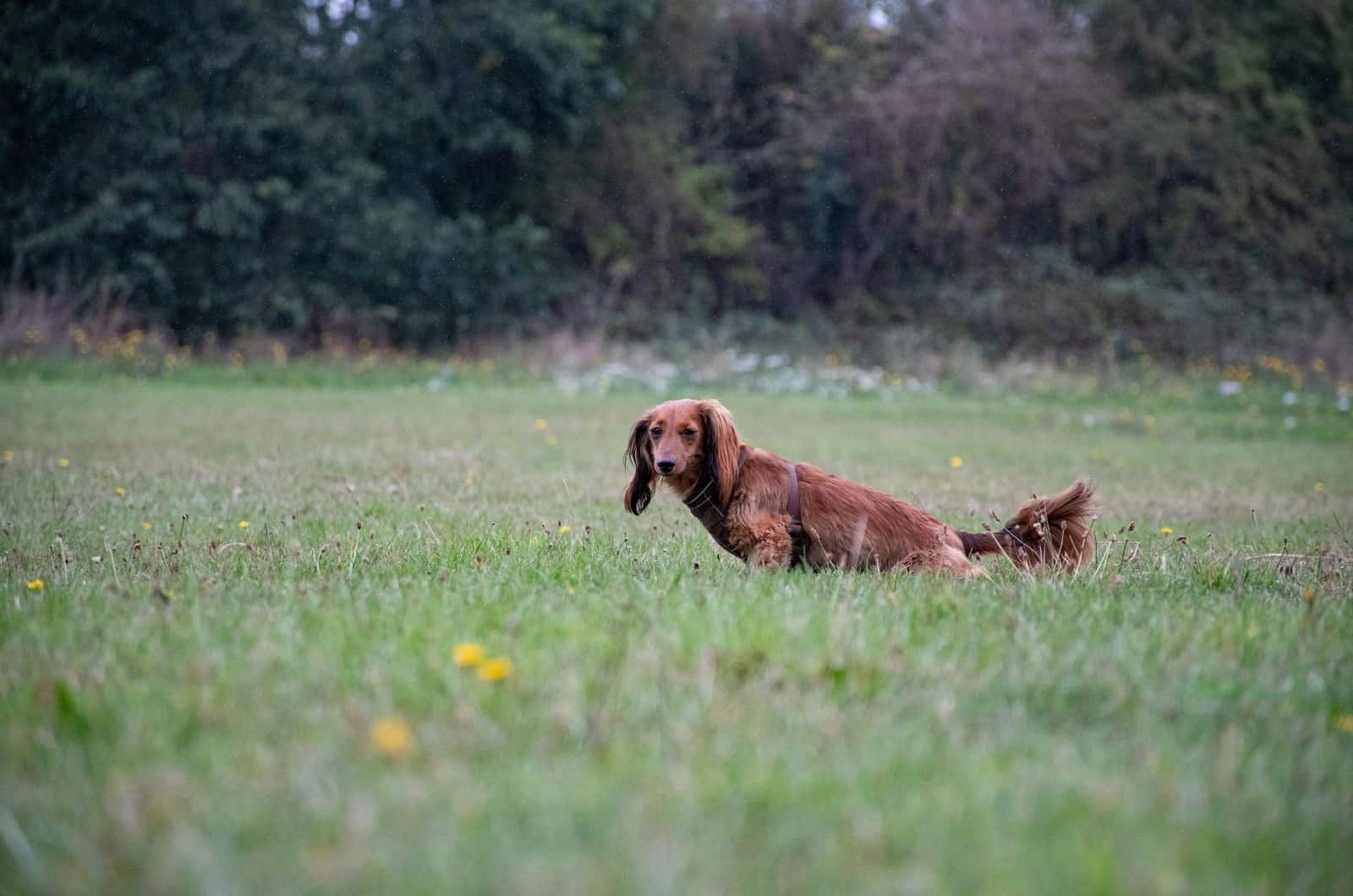
An older Dachshund might be challenging to housebreak. Dachshunds are obstinate, and they frequently have strong opinions. Regularly let him out, and crate him (shortly) when you leave the room.
He needs time to learn, so be attentive and continuous.
Consider any recent adjustment that may have occurred as well. Some Dachshunds engage in a behavior known as “marking,” during which they urinate on household furnishings or other objects.
After you move into a new home, buy a new dog, or have a kid, they might start acting this way. Put him back in boot camp and resume your normal schedule.
If he continues waking up in the middle of the night, he might be putting excessive amounts of liquid in his bladder before bed. Consider bringing your Dachshund out right before he goes to sleep. Also, make sure he has a meal at least five hours prior to going to bed.
Get him to fall asleep in a crate if you believe it is a nervous issue. This should prevent any incidents, and give him a sense of security.
With elderly dogs, it’s advisable to be cautious and consult a veterinarian to clear out any major issues. If everything is well, and it’s just an age problem, you might want to try Dachshund diapers.
How Do You Potty Train A Dachshund Puppy: Training Tips
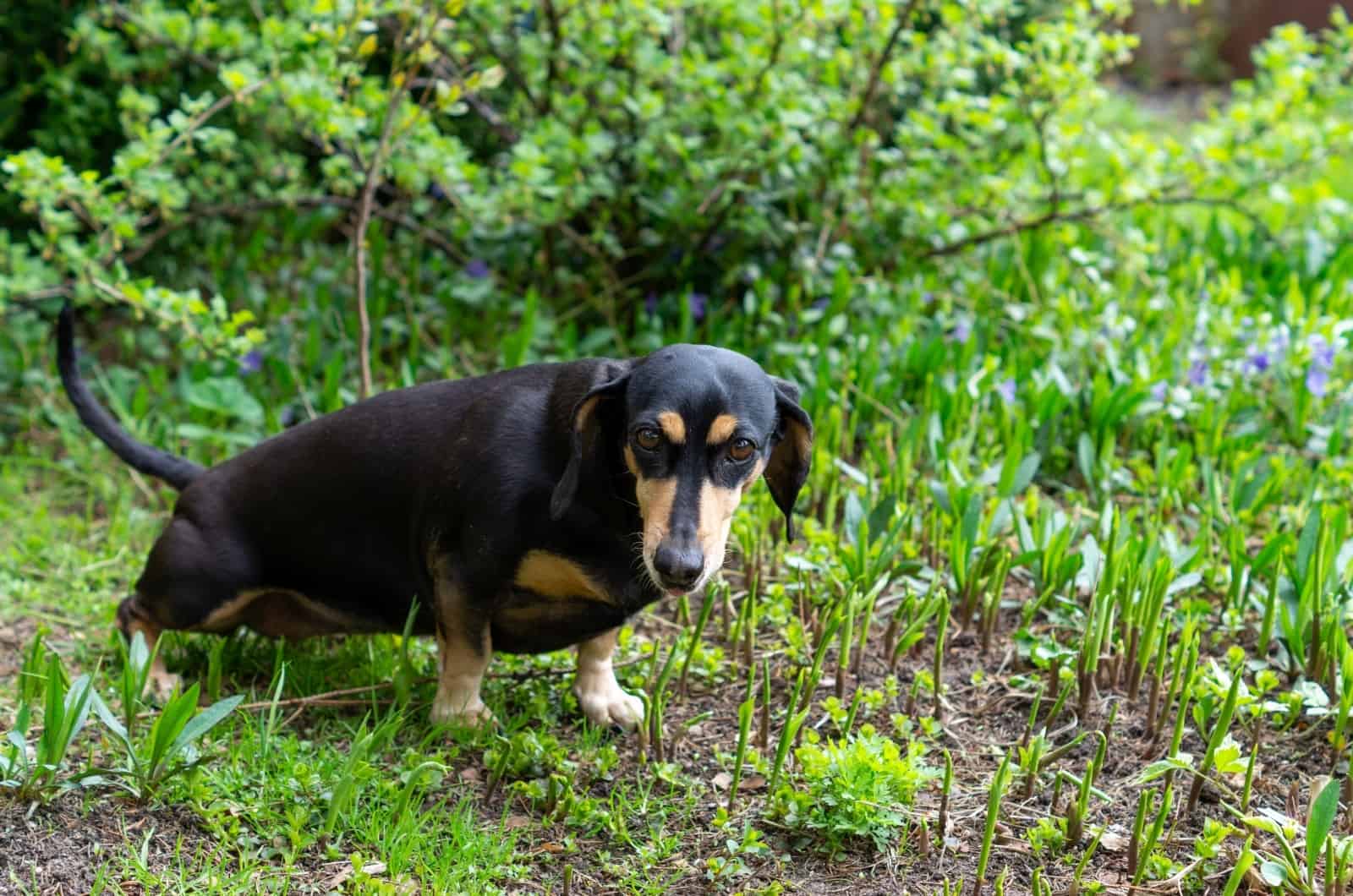
Even though it’s simple to become upset when your dog seems to have an accident, remember that it’s still discovering, and doesn’t know that using the restroom within your house is improper.
Even as accidents happen, effectively housebreaking your Doxie reduces the likelihood that you’ll return home to an unexpected mess.
You may practice with your dog no matter its age because both pups and adults can be schooled.
If you’re tolerant and persistent, you can train your Doxie even if you might occasionally have to tidy up after your dog.
1. Bring Your Doxie Outdoors
Throughout the day, take your Dachshund out every two hours. Your Dachshund will have regular intervals when it has to go outside, even though you won’t be able to foresee when it will do so.
Take your Doxie outdoors as soon as possible so it can go potty after waking up, finishing breakfast, or having play time. Before retiring for the evening, you ought to attempt taking it outside.
You should try to take your dog out at minimum once every two hours, despite the fact that it could seem boring.
The number of hours that a dog can typically last without going potty is determined by how many months old the dog is. Therefore if you own a Dachshund that is 4 months old, you could only leave it indoors for a maximum of four hours.
Note that this doesn’t mean that if your dog is 12 months old, you can leave it indoors for 12 hours. This is only regarded for the first puppy stage that lasts until the Dachshund pup is six months old.
2. Have A Close Eye On Your Doxie’s Body Language
Check to see whether your Doxie is crying, howling, or circling. Even when you allow your Dachshund out around every two hours, you might notice some additional signs that indicate you must let it out sooner.
As quickly as you can, take your dog outside to relieve itself if it is circling on the ground, showing stiff rear legs and a nervous tail, whimpering, or starting to whine. This will prevent you from having to deal with an unfortunate incident.
Keep a watch on your dog throughout the day because it might try to sneak away to use the restroom in a separate room. Try to confine your dog to one or two rooms if you’re really concerned about it pooping or peeing on your floors.
3. Take You Doxie To Potty Outside In The Same Place
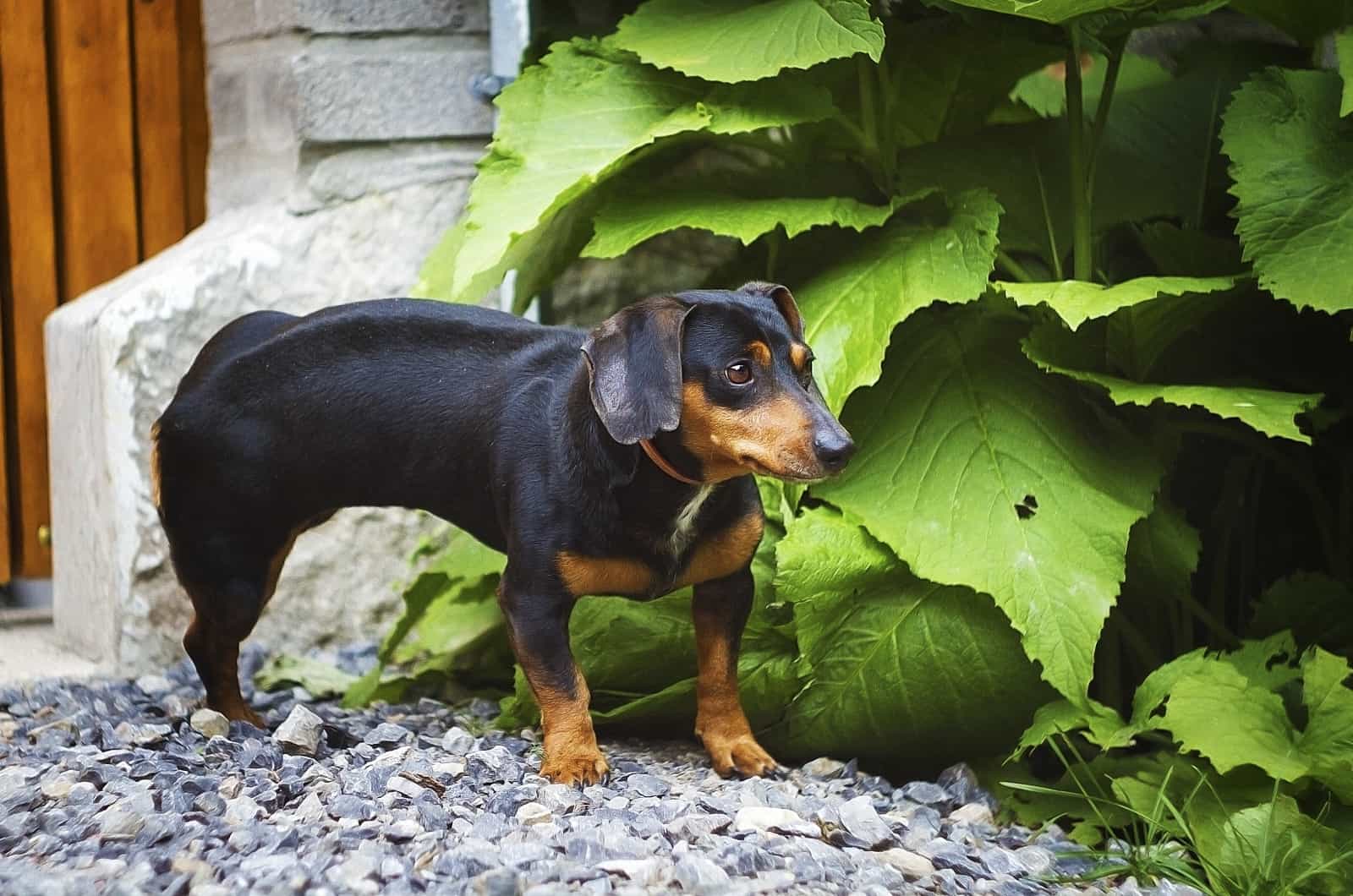
Whether the location is in the back yard or on the route of your normal walk, it doesn’t matter — just make sure you can access it each time your dog wants to go outdoors.
To ensure that your Doxie remains concentrated on training, if at all possible, pick a location that is peaceful and free of many distractions. Also, keep the Doxie on a leash so that it doesn’t leave the area you’ve chosen.
Take your Doxie to the exact same spot every time, even if it might not appear to be the most crucial thing to do. Dachshunds learn most effectively from consistency, so if you take them to a strange bathroom location, they can get confused.
4. Get Your Doxie Used To A Certain Word When Going Potty
Give your Doxie the command to go potty in order to get it motivated. Due to its keen sense of scent, your Doxie can take some time to sniff about and explore before using the restroom.
Please be patient and give your dog some time to adjust; this is entirely natural. Say something, such as “potty” or “go” to urge your Doxie to relieve itself so that it understands what to do.
Whenever you take your dog outside, resist the urge to play with it because if you do, your dog won’t understand whether to go potty or play.
5. Praise And Use Positive Reinforcement Methods
The secret to potty training success is positive reinforcement. Your puppy will learn that using the restroom outside is rewarded through positive reinforcement.
Give your puppy food, verbal praise, or their favorite toy right away after each time they go potty outside. In order for your puppy to form a good association with going potty outside, the treat should come right away after the action.
After your dog goes potty, give it praise and treats. When your Doxie finally relieves itself, it’s time to party. Pet your dog, and use a positive tone of voice to praise it for a job well done.
Even a tiny treat or a bit of snacks can be given to your dog as a reward to help it develop a favorable connection with going outside.
For instance, while your dog is going potty, you may say something positive and encouraging like, “Good dog!”, and then reward it with a goodie.
6. If An Accident Happens, Interrupt Your Doxie With Loud Noise
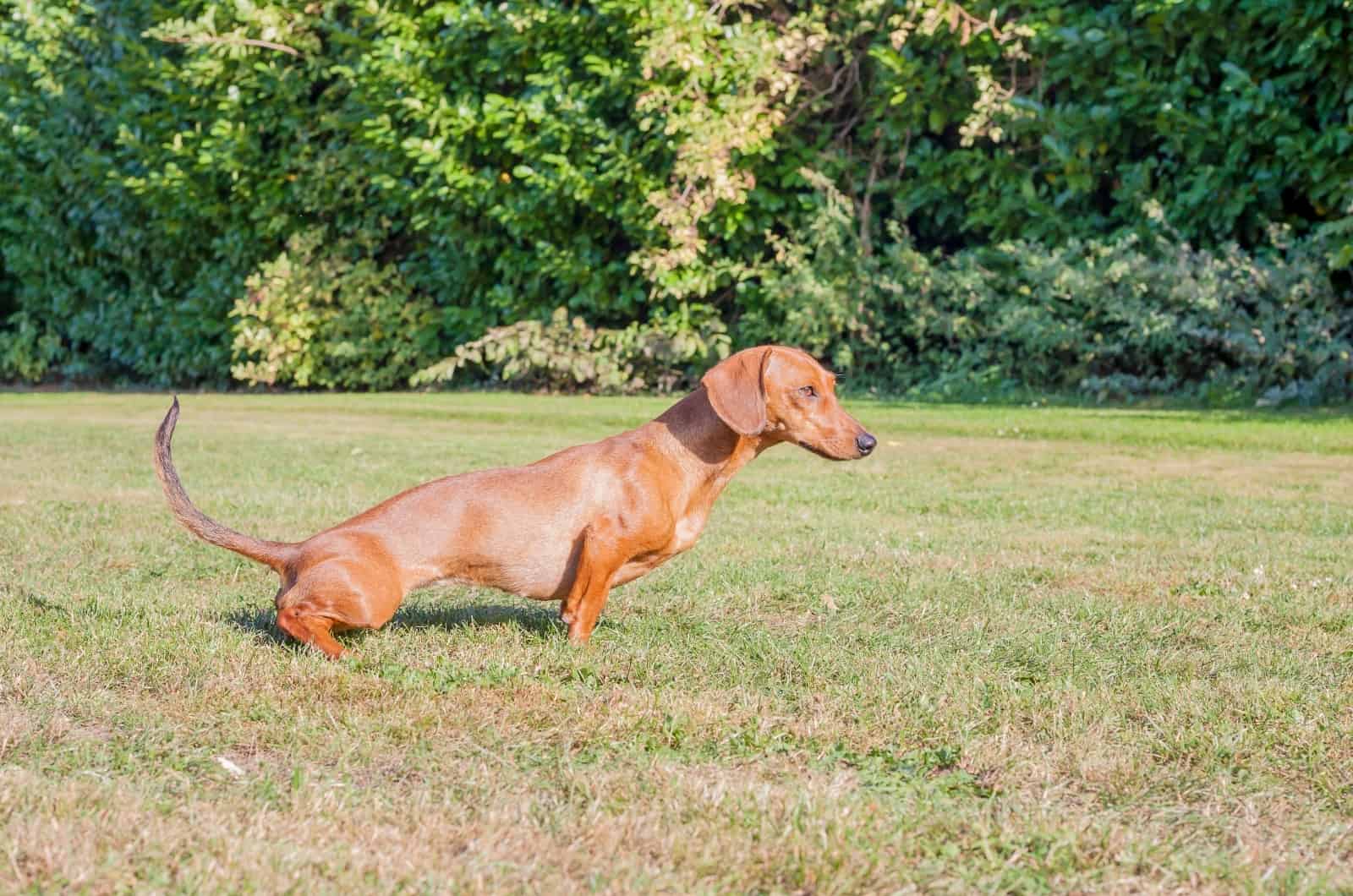
If you see your dog going potty inside, command it to stop. You may be able to stop your dog from going potty indoors even if it has already started so you won’t have to do as much cleaning.
As quickly as you can, put an end to your Doxie‘s negative behavior so that it will learn from it. Clap vigorously or sternly, but calmly say “no” to shock your dog and get it to stop.
If you startle your dog, it can try to conceal it when it wants to use the restroom, so if your Doxie has an accident, refrain from shouting at it or scolding it.
7. After The Loud Noise, Take Your Doxie To Its Potty Spot Outside
Go outside right away with your Dachshund. You immediately need to control it, so grab your dog and take it to the designated toilet area. If it takes a little longer than expected to finish, be tolerant and wait with it.
To get it to start going once more, you might try using the potty word you chose. When your dog has finished, give it praise so that it will understand that indoors is off-limits.
Be caring and kind toward your Doxie after it finishes outside despite the fact that it experienced an accident, and that you may be irritated. This will help you stay persistent with training.
8. Let’s Try Crate Training!
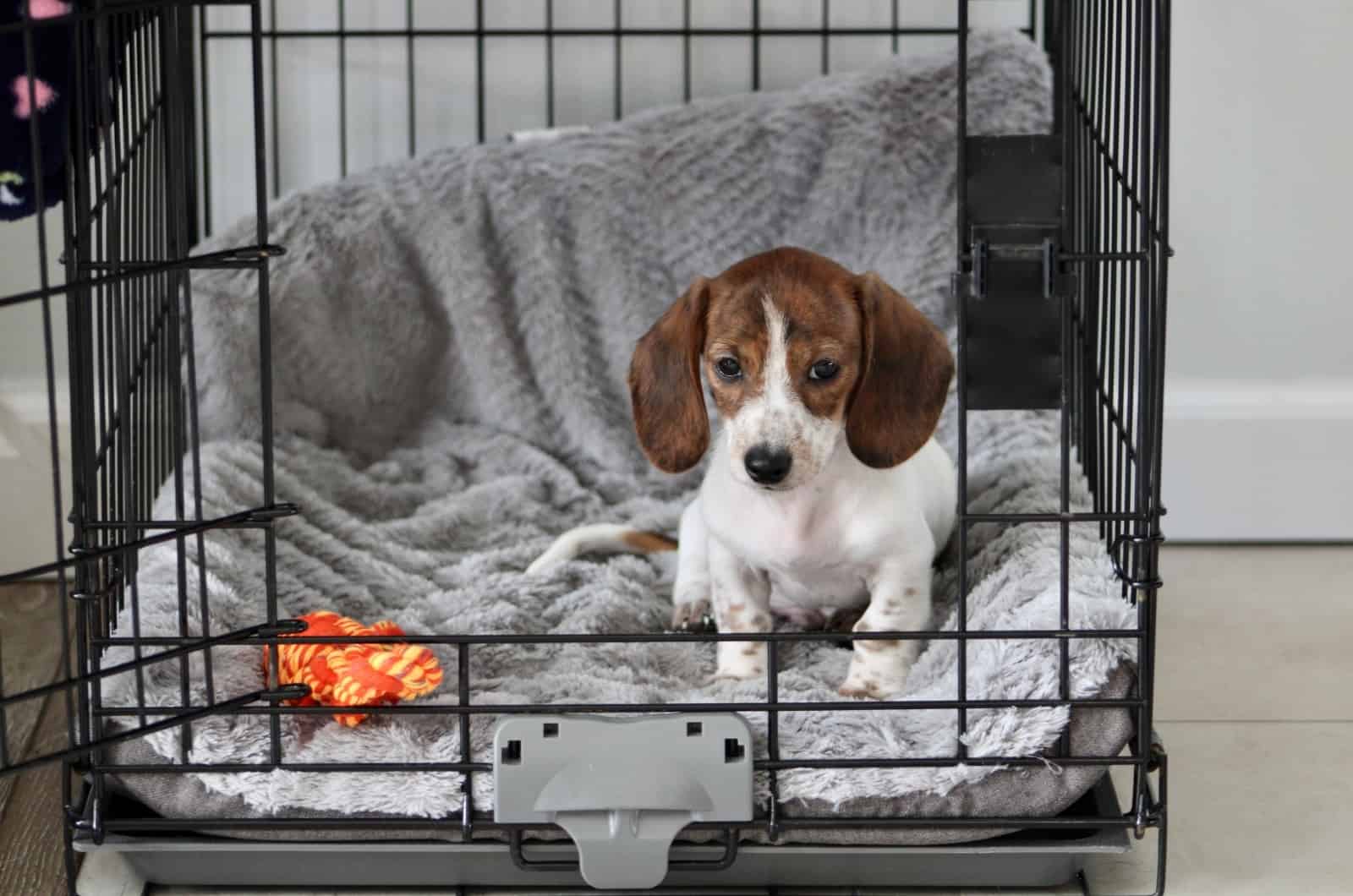
Adult Dachshunds and older dogs might benefit from crate training as well. Unlike puppies, they prefer not to urinate in places where they sleep as well as eat; thus, they will refrain from doing so in a kennel that has become their permanent residence.
Just enough space should be provided for your dog to stand up, rotate, and lie down inside the crate that you are using to discipline it.
Anytime your sausage dog cannot be closely watched when you’re potty training it, he or she ought to be kept in a kennel for naps, nighttime, and other times. Never use the crate as a form of punishment.
It’s crucial to remember that adult dogs could require longer time to get used to a kennel. You should speak with your veterinarian about additional choices if your dog is displaying indications of stress or fear as a result of the crate training process.
Your dog should regard its crate as a comfortable haven where it can rest. Avoid purchasing a box that is any bigger than you require because your Doxie might have enough space to take a nap on one side and relieve himself on the other.
Except in exceptional circumstances — for example, if you live in a high-rise apartment or have restricted mobility — puppy poop and pee pads should never be utilized as a replacement for going outdoors.
Puppy confusion about where to relieve themselves can result from letting them use pee pads indoors. Avoiding this (if at all feasible) will help the potty training practice go more quickly.
Experts claim that this is one of the best answers to ‘how to potty train Dachshund’, and that it is an effective method from when the puppy is only 4 weeks old.
Let The Dog Feel Relaxed Around Its Dog Crate
Have the dog crate accessible, so that your dog will feel at ease around it. Your Doxie could be fearful the first time you introduce a brand new crate to him. The crate should be a safe space for you Doxie when you leave it home alone!
Place the crate inside the room in which you and your dog enjoy the majority of time, and leave the door open entirely. To help your Wiener dog grow used to the crate being there, let it explore the room on its own.
Add various toys or its preferred treats inside to entice your Doxie to explore the crate if it displays any hesitation or fear.
To start making the crate extra cozy, you could also place a sheet or towel on the bottom.
To avoid your doxie developing bad connotations with the crate, don’t ever push your dog in it or use it as a ‘jail’.
This Might Seem Crazy, But Feed Your Dog In Its Dog Crate
Put food in the crate for your dog to eat. When your dog is capable of getting into and out of the crate on its own, simply place its food bowl nearer to the end of the crate during meals.
As soon as your dog enters the crate and begins to eat, slowly close the door. Avoid making a big deal out of it because doing so can frighten your dog.
Open the door as soon as it finishes eating, and give your Doxie praise. Next time, once your dog finishes eating, the door should be closed for a little while longer.
After meals, gradually train your Dachshund to spend 10 minutes in the crate. Be sure to reward it with lots of praise.
To prevent your Doxie from feeling lonely while being crated, remain in the area. You might have attempted to extend the duration too rapidly if your Dachshund begins to complain. I know… being a dog trainer is not easy, but don’t give up.
Allowing your dog out right away will teach it that whimpering always gets it what it wants. Alternately, cut back on how long you leave it in the kennel after the subsequent meal.
Let The Little Pup Get Used To The Crate
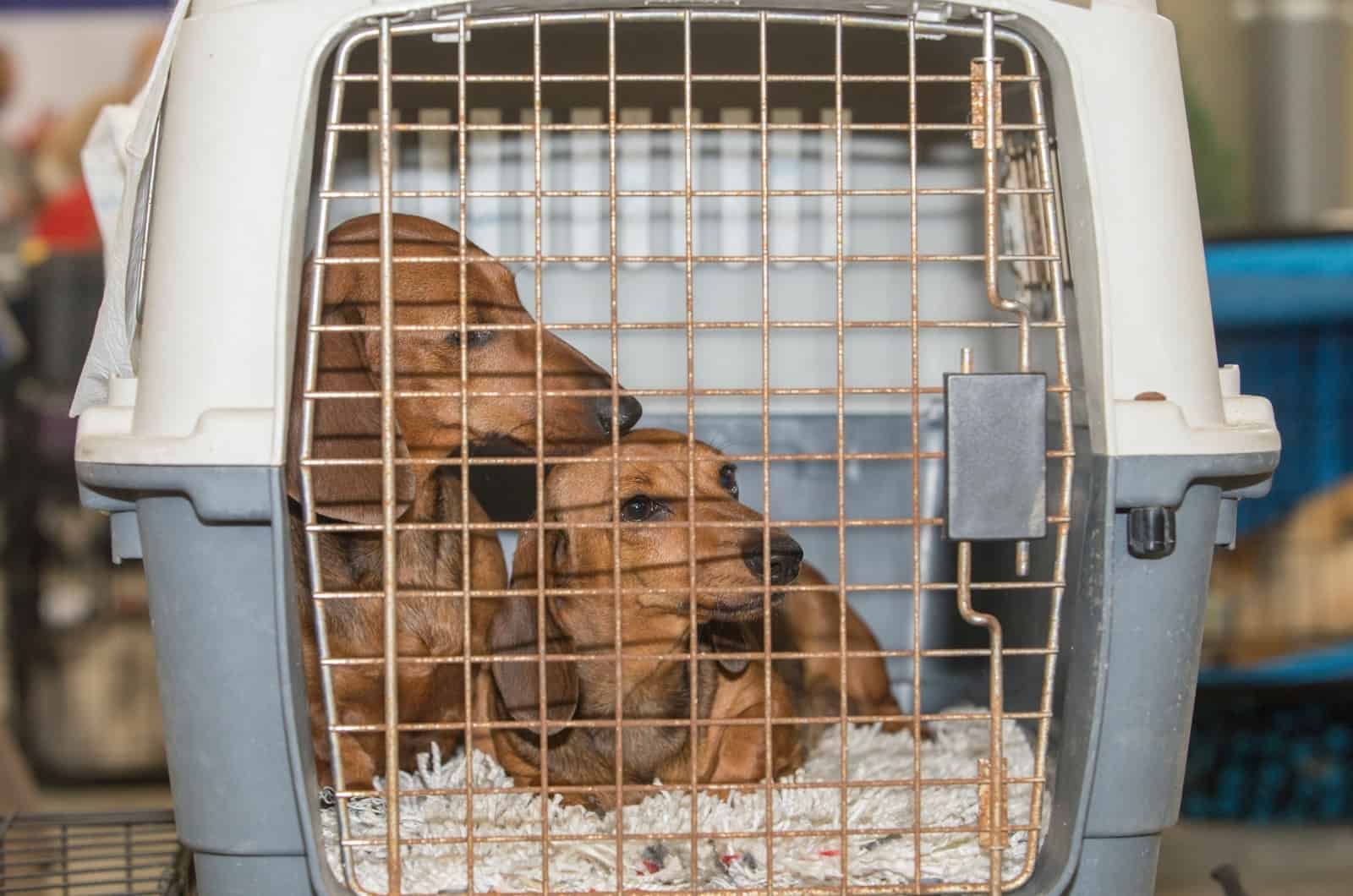
Increase the length of time you keep your Wiener dog in the crate. You should be prepared to utilize the crate as a diversion if your Doxie won’t become anxious when eating in it.
Treats should be used to lure your dog inside the crate before you close the door. Spend five to ten minutes sitting next to your dog to prevent boredom or discomfort.
After that, wait for a while in a separate room. Return to the cage and hold off allowing your Doxie out for another half-minute or so. A few times throughout the day, try this, extending your absences until you hit 30 minutes.
Don’t keep your Doxie in its crate for longer than four hours throughout the day. While it may be appealing to let your dog out as soon as it starts to whine, wait until it stops or else it’ll start to behave that way, and begin to connect crying with you unlocking the door.
Try To Leave Your Wiener Dog In The Crate Overnight
You should hear if your Wiener dog has to go outside when it is in its cage overnight. You may prefer to keep your dog in the cage instead because it’s understandable to be concerned about what he might get into at nighttime.
Move the crate inside your bedroom, so that your dog won’t feel lonely during the night. Don’t get annoyed if your dog starts to whimper or whine because it is keeping you up.
Instead, spend a few seconds talking to your dog to help it relax. You will be able to tell when your dog has to go outdoors, and you may then let it out.
This method is effective for both old Dachshunds and Dachshund puppies. Many say that this is more of an effective dog training method than learning with potty pads.
FAQs
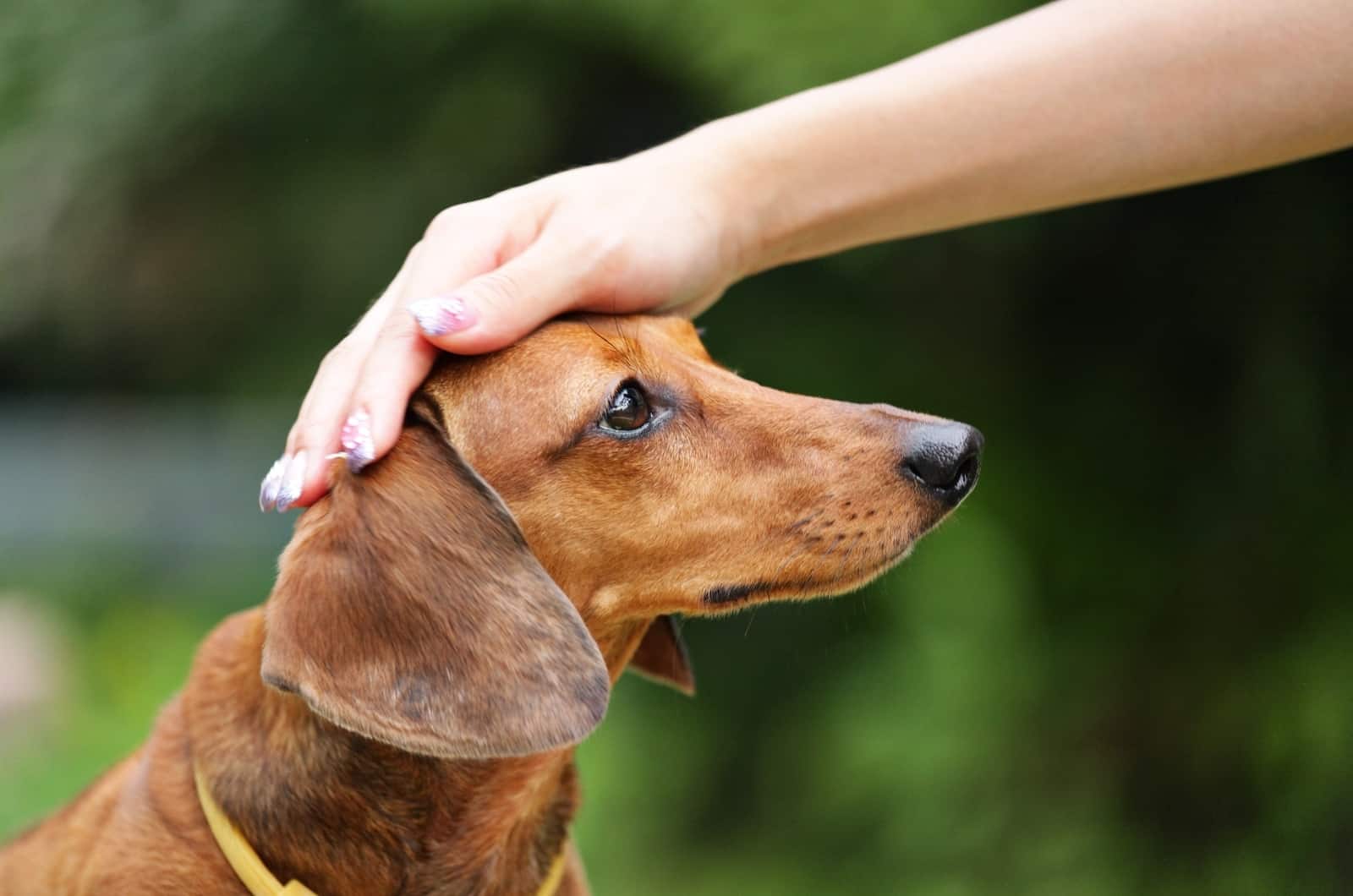
1. How Do You Housebreak A Stubborn Dachshund?
Their huge personalities do not match their small body. Dachshunds are known to be stubborn, head-strong, and some dog owners even say aggressive when things don’t go their way, and they are definitely dogs that have a mind of their own.
Does it feel like your dog is deliberately trying to challenge you? Please understand that no dog is forcing you to clean up his mess out of malice or to irritate you.
Your puppy adores you and desires a close relationship. Accidental urination and defecation are never a clue that a Doxie is mean or trying to hurt you.
It’s crucial to avoid being angry or abusive with your dog. He is a baby who is only now learning about the outside world! You must create a welcoming and secure environment for him. Never let him think you’re erratic or cruel.
Among the most difficult aspects of raising a dog is potty training. Even though you feel as though you followed all the right steps, daily slip-ups leave your home dirty and prevent you from enjoying time with your puppy.
We are interacting with cheeky, yet perky… independent, yet dedicated pups since they developed a significant amount of courage and determination over generations of combat with pests.
Even though they are only the size of a lap, it is not uncommon to witness them battle animals that are larger than they are.
They are intelligent, playful puppies whose innate tenacity and curiosity are heightened. The ego of Dachshunds makes them one of the hardest canines to train.
A cunning Dachshund will constantly look out for what’s best for themselves; therefore, your goal is to act a little sneakier than them.
2. What Is My Dachshund’s Bladder Capacity?
Puppies’ urine output is assessed in the clinic by using a catheter connected to a tube and a urine-collecting bag when they are believed to have renal disease or even other endocrine illnesses.
As a result of decreased urine production brought on by renal disease, potentially fatal toxemia can develop. That is why it is important to answer the question, ‘how to potty train a Dachshund’.
Dogs generate enormous amounts of pee in several hormonal illnesses like Cushing’s disease and diabetes because they are unable to concentrate their urine.
2mL per kilogram every hour is the estimate for a healthy urine volume. As a result, a 3-pound pup (1.5 kg) must excrete 72 mL of urine each day, or 3 mL every hour. To give you an idea, a teaspoon contains 5mL.
Dogs, particularly pups, urinate more frequently than usual. Usually, they compensate for this by consuming more. Some dogs enjoy drinking water, which causes them to urinate more.
Never try to limit how much water your dog consumes. Your puppy should be examined by a veterinarian if it continues to urinate in excessive amounts.
3. Are Dachshunds Hard To Potty Train?
As hunting dogs, Dachshunds can be challenging to train. A number of sounds, images, and smells are also distracting.
Potty training might take a little longer with a Doxie than with other dog breeds since they prefer to smell everything rather than focus on the potty.
It would be dreadful if your paw pal urinated on the blanket because Dachshunds enjoy sleeping beneath covers, and it will be challenging to clean your bedding. It is commonly known that Dachshunds can be a little stubborn. However, they are intelligent and creative.
In contrast to other dogs, they favor doing things their own way. Because of this, successful potty training requires tolerance and tenacity. If you don’t, be prepared for them to refuse your commands and training sessions!
4. How Do I Stop My Dachshund From Running Away?
It can be upsetting for you and dangerous for your dog whenever they run out of the house or out of the yard. A rogue dog runs the risk of hurting someone, being struck by a vehicle, or being attacked by another dog.
Pretty much every single dog may occasionally escape, but if this happens frequently, such as once a day or once a week, it’s important to determine how to keep the dog safe in the yard or house.
There are several reasons why dogs run away. When they spot a squirrel, their innate hunting instinct may cause them to flee.
Your dog can take off to begin a lively round of catch and anticipate your pursuit. The dog might be aware of a covert exit through a gap in your fence. You can simply avoid the aggravation of frequent dog escapes by teaching your dog to obey simple commands like sit, stay, and come.
You and your dog can learn dog training methods together at dog obedience school, and create an enduring relationship of loyalty. Most importantly, you’ll protect your pet from the numerous dangers it can face if it tries to flee. A trained dog is one that is safe.
Positive reinforcement is used in efficient dog training. This means that you should reward your dog with praise or treats when they behave well. Ignore your dog’s bad behavior when it occurs.
Training your dog affects not just your conduct, but also that of your puppy. Do you pursue your dog if it escapes? If that’s so, the dog might consider this to be playing, and attempt to flee repeatedly just for amusement.
Do you cruise around the neighborhood to get your dog back into the car? If your dog loves car journeys, using this method could encourage this behavior. Consider the possibility of you training your dog rather than the other way around.
Final Word
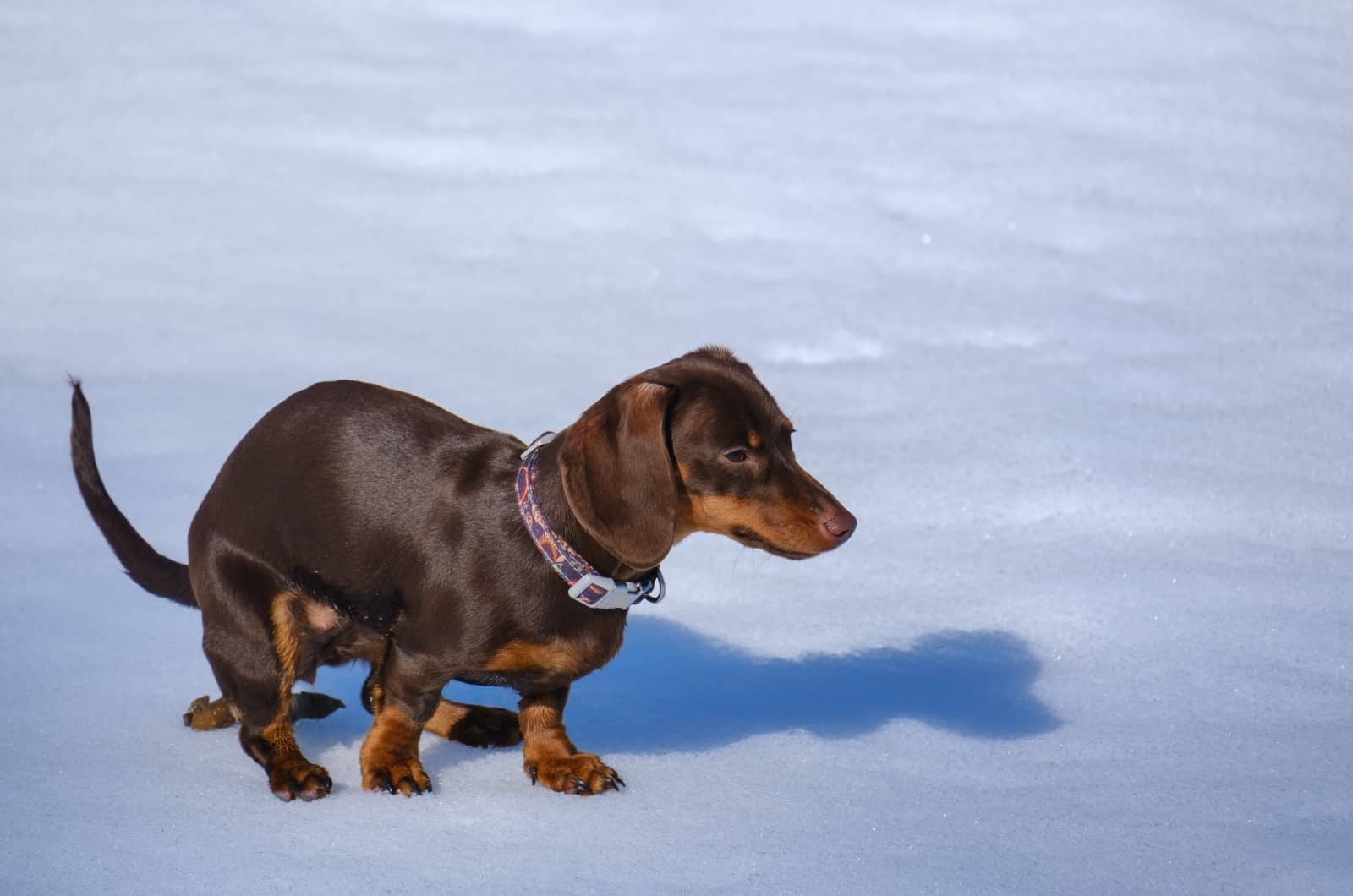
Dachshund owners, vets, and behaviorists have come together to answer the question, ‘how to potty train a Dachshund’ from a personal experience.
The first week may be challenging for both you and your new Dachshund puppy, but with hard work and discipline, you will get to your destination in no time.
There are several things to think about, including your tactics and consistency, the dog’s age, its learning background, and other considerations. Developmentally speaking, a puppy at 8 weeks old is considerably different from a puppy at 5 months old.
Some puppies develop impeccable manners in a matter of days. Others could take months, particularly if the dog was in an unfavorable setting before arriving to you. But, most dogs are teachable with time and effort.
You must keep a close eye on your puppy to spot unique rhythms and signals. It’s possible that some puppies can hold their pee longer than others. People will pause while playing, urinate, and then resume playing, and canine potty habits are just like those of humans.
It can be “tricky” to utilize puppy pads for teaching since you’re giving the puppy two alternative possibilities to learn. Puppies would ideally be taught to hold it inside and only go potty in designated areas outside.
However, there are some situations that can call for a little ingenuity, such as for a person whose employment prevents them from returning home frequently or for a small puppy living in a harsh winter climate.
A dog has the choice to relieve herself in an authorized location inside the house, thanks to puppy pads. There are also cutting-edge indoor dog restrooms that accommodate both male and female canines. However, when the dog is older, the owner can strive to train it to relieve itself exclusively outside.
